Appalachian October Fall Beans
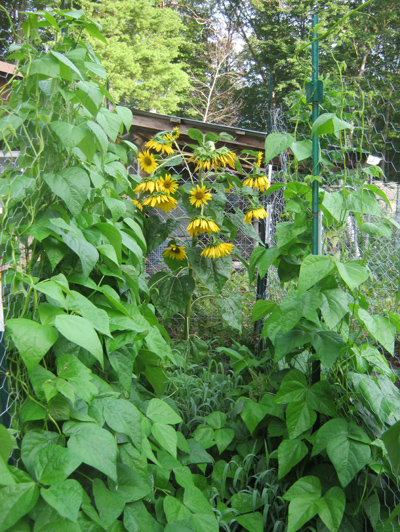 |
History
That Lives On
"I
grew up in Winston-Salem and lived there for 37 years and my friends dad
used to grow them. I grow some heirloom tomatoes from seeds passed down
from my grandfather and would love some of your October beans to grow."
-Grant, Talladega Alabama
"I've been searching everywhere for this bean. My Mammaw always grew
it on her mountain farm, and it was my favorite. Can't wait to get this
growing on my own farm." -Angel, 2 Angels Mushrooms, Harrison, Tennessee
"I grew up eating these October beans. I lost the bean seed after my aunts and uncles and Dad died. They're all from Eastern Kentucky." -Rudy, Wanatah Indiana
|
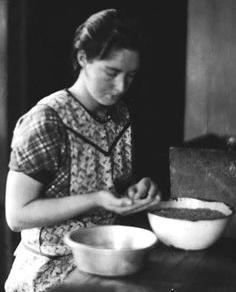
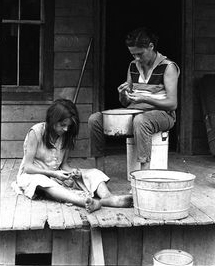 |
Rural
Living: Shelling Beans
"My 82 year old mom remembers her mother making October beans and she
hasn't had them since she was little. I'm so happy you have them! :)"
-Theresa, Riverview, Michigan
"My husband who is from Salem, Virginia
grew up eating october beans, his grandparents grew them. According to my
husband they are the 'Delicacy of the bean world' ". -Merichristi, Mebane,
North Carolina
"I was so excited to find October Beans. I grew up in Cherokee, NC and remember eating them all the time. The last two visits back I have looked for seeds but could never find them. People in the stores out here in the west havenít heard of them and I didnít know their scientific name. I only have small gardens right now, but looking forward to see how these do out here." -Antonio, Lapwai, Idaho
|

|
Enjoying
Home Grown Food
This photo
is a springtime ramp social supper in West Virginia. A ramp is a wild onion
that grows in Appalachia.
"Our pastor is from western NC and is missing these
beans somethiní fierce! He is the reason I began the search for the difference
between cranberry beans vs. October beans, and how I could obtain some of
the Ďrealí thing to cook for him!" -Pat, Cary, North Carolina
|
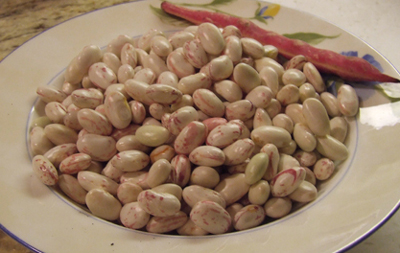
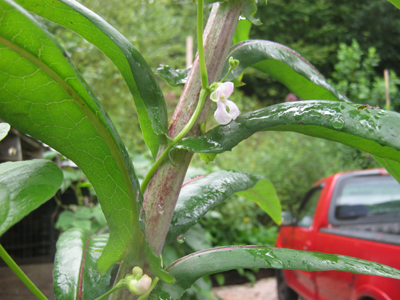 |
Cooking
October Beans Southern Style
The traditional
Appalachian way to cook them is to shell the beans. Then season with a piece
of ham hock or fatback (salted pork fat). Cook slowly (low boil) with onions
and herbs until they are creamy and soft. They are best served with cornbread.
They have a rich, earthy, robust, chestnut-like flavor. I love them.
Young pods are great cooked too. Also good in soup, salad, and casseroles.
"I have been trying for years to find the beans
that my Grandmother used to cook when we were visiting. She lived in East
Tennessee, and the seeds had been handed down through her family for a long
time. She cooked them both as snaps and dried beans, and they had the most
amazing flavor, an order of magnitude better than the tasteless crap available
these days." -Carter, Milledgeville, Georgia
|
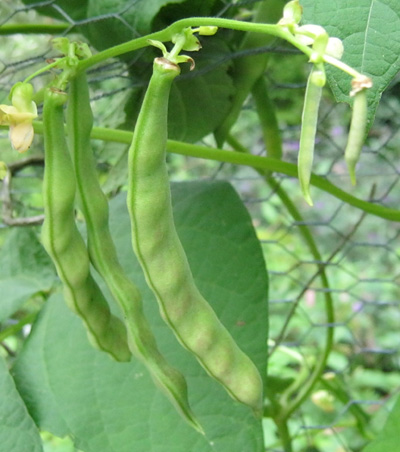 |
Eat
Them at All Stages of Growth
Sometimes
called Speckled Cranberry, French Horticultural, or corn field bean. This
is a very rare variety of October bean. I'm happy I was able to save it.
The pods start out green and as they mature they turn a light red, bright
red, purplish-red, purple, then brown.
October beans can be eaten at all stages of development (green snap or shelly/shelled).
This photo is the young pod at various stages of development. Cute little
baby beans.
"I've heard of October beans for many years and
finally realized that as much as I like eating dried beans, these should
become a farm staple. Why did I wait so long to reach this conclusion?"
-Lisa, Bishop, Georgia
"A dear, 75-year-old friend has asked me to grow these for her."
-Victoria, Sparta, Tennessee
|
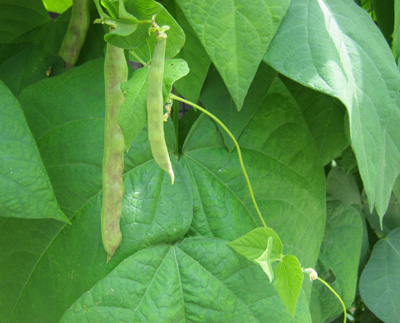 |
A Good
Homestead Bean Plant
A very good
bean for a self-sufficient homestead.
Easy to grow, good producer, easy to shell, no strings, tasty.
"As a child, we ate pintos and white beans most
of the time. Then my folks found something they called October beans that
reminded me of pintos but that I actually liked better. They grew them.
They shelled easy, and we would freeze them. I've missed them since childhood;
so excited to find some and hopeful to try to grow some!" -Vicki from
Spartanburg, South Carolina via a farm in Guilford County, North Carolina
"Thank you so much for growing enough of these special beans to share."
-Amy, Boone, North Carolina
|
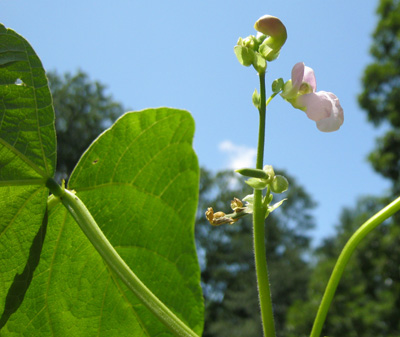
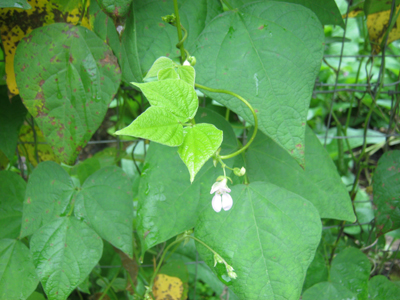 |
Preserve
a Heritage Bean
A popular
bean among old timers. Grown for generations. Join us in preserving this
variety.
This photo is the pink flower the bean plant produces.
"I grew October beans years ago (maybe 35 years?),
and I would wait til the pod would have a leathery feel, then I would put
them into a quart jar, 1 teaspoon salt, and water and pressure cook them.
I did about 50 quarts. I'm here to tell you they are the best. I have not
been able to find them sinceÖ.so I'm thrilled to have found you." -Jude,
Arlington, Washington
"I lived in North Carolina about 1975-76 -- I helped my father-in-law plant and grow October beans and other vegetables on his small acreage as many other poor folks there had to do. I loved the October beans my mother-in-law cooked and really would like my current family to know what I speak of." -Lee, North Carolina
|
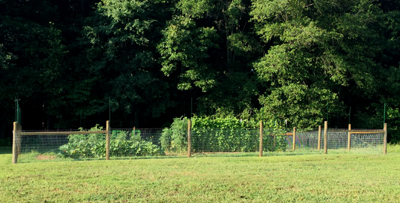
|
October
Bean Wall
This photo
of October beans is from Leigh in Richburg, South Carolina.
"The October's texture was really creamy. I had
never grown those before, and it's my new favorite. I didn't shell them,
we ate them in the pod. The picture shows how healthy my bean walls (as I call them) are. So easy to grow and
lots, I mean lots of beans. I did pick often." -Leigh
|
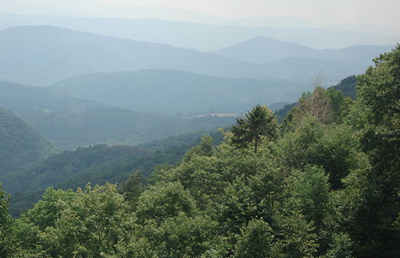

|
Appalachian
Life
"I have
been looking all over for a seed source for October Beans. Your site is
the only one that seems to understand and have a genuine connection to the
Appalachian tradition of the pole habit version. Thanks so much for your
assistance and your commitment to preserving Heritage."
"I have a 1000 square foot garden in my back yard in town and grow only
Heirloom or classic F1 hybrid vegetables. I try to use natural or organic
techniques as much as possible. What we donít eat or put up I bring to our
local farmerís market to sell and educate people about the joys of gardening
with such beautiful and unique vegetables." -Rusty, Beaumont, Texas
|
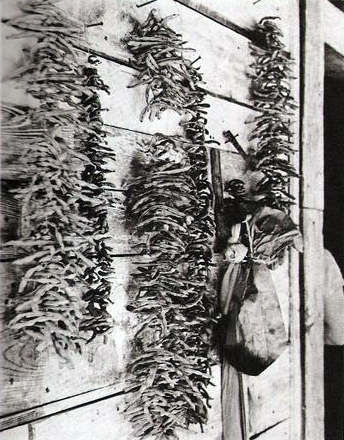 |
Leather
Britches (Breeches)
"String
tender green beans. Fill a long needle with a long strong thread. Push the
needle through the center of the bean, pushing the beans together at the
end of the thread, filling from knot end to needle. Hang up the string by
one end in the warm air, but not in direct sunlight. This gives the bean
a better flavor. Let them remain hanging until they become dry. Store in
a bag until ready to use." -The Foxfire Book, p.175
"Sometime during the winter take a string of dried green beans down, remove
the thread, and drop them in a pot of scalding water. Then add a good hunkía
meat and cook all morning." -The Firefox Book, p. 167
"I am interested in growing these since I used to enjoy my grandmother's October beans and quite a few folks have no idea what an October Bean is. These look like what we used to harvest when I was young." -Sam, Oak Ridge, North Carolina
|
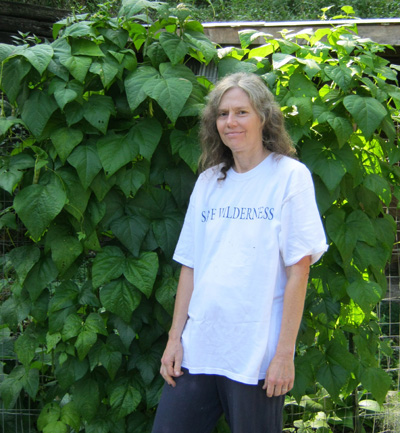 |
October
Beans: The Tradition Continues
This photo is Nancy in front of her October bean plants in 2015.
"I've looked for this bean for years. My Father
(lived in Virginia all his life) grew October beans that were so tasty.
I live in Florida and people around here never heard of October beans. Daddy
always had cornbread and onions with his beans and teas or buttermilk to
drink. Oh my, do I remember those days, when I was growing up in Virginia."
-George, Sarasota, Florida
"I bought some October beans in North Carolina several years ago and
really enjoyed them. I like the flavor of this bean." -Donna, Florida.
|
|













